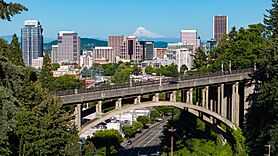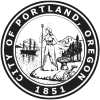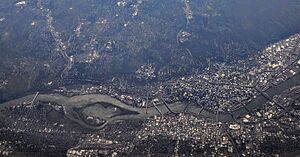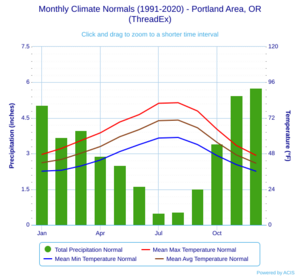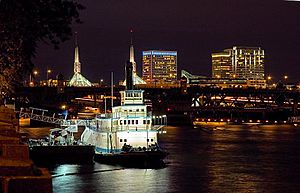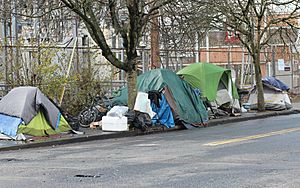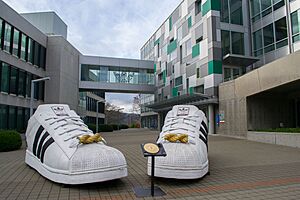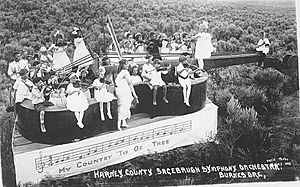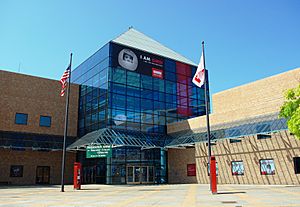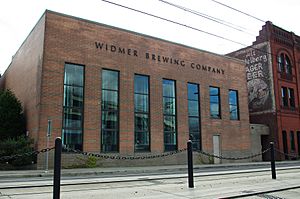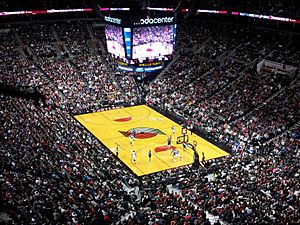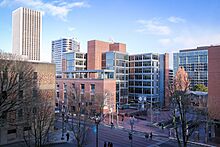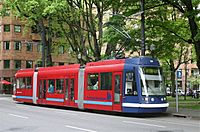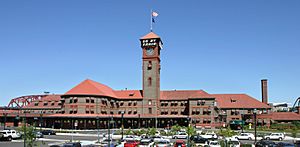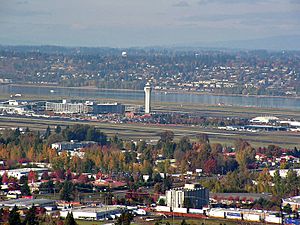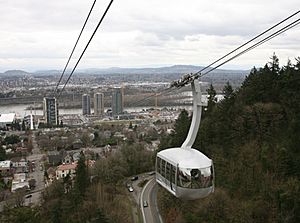Portland, Oregon facts for kids
Quick facts for kids
Portland
|
|||
|---|---|---|---|
|
|
|||
|
|||
| Nickname(s):
"Rose City"; "Stumptown"; "PDX"; see Nicknames of Portland, Oregon for a complete list.
|
|||
| Motto(s):
"The City that Works"
|
|||
| Country | United States | ||
| State | Oregon | ||
| Counties | Multnomah Washington Clackamas |
||
| Founded | 1845 | ||
| Incorporated | February 8, 1851 | ||
| Named for | Portland, Maine | ||
| Government | |||
| • Type | Mayor–council government | ||
| Area | |||
| • City | 145.00 sq mi (375.55 km2) | ||
| • Land | 133.49 sq mi (345.73 km2) | ||
| • Water | 11.51 sq mi (29.82 km2) | ||
| • Urban | 519.30 sq mi (1,345.0 km2) | ||
| Elevation | 161 ft (49 m) | ||
| Highest elevation | 1,188 ft (362 m) | ||
| Lowest elevation | 0.62 ft (0.19 m) | ||
| Population
(2020)
|
|||
| • City | 652,503 | ||
| • Rank | 74th in North America 26th in the United States 1st in Oregon |
||
| • Density | 4,888.10/sq mi (1,887.30/km2) | ||
| • Urban | 2,104,238 (US: 23rd) | ||
| • Urban density | 4,052.1/sq mi (1,564.5/km2) | ||
| • Metro | 2,511,612 (US: 25th) | ||
| Demonym(s) | Portlander | ||
| GDP | |||
| • Metro | 8.894 billion (2023) | ||
| Time zone | UTC– 08:00 (PST) | ||
| • Summer (DST) | UTC– 07:00 (PDT) | ||
| ZIP Codes |
97086, 97201-97225, 97227-97233, 97236, 97238-97240, 97242, 97250-97254, 97256, 97266-97269, 97280-97283, 97286, 97290-97294, 97296, 97298, 97214
|
||
| Area codes | 503 and 971 | ||
| FIPS code | 41-59000 | ||
| GNIS ID | 2411471 | ||
Portland is the largest city in the U.S. state of Oregon. It is located in the Pacific Northwest region. The city sits where the Willamette and Columbia rivers meet. It is the main city of Multnomah County.
In 2020, Portland had a population of 652,503 people. This makes it the 26th largest city in the United States. It is also the sixth largest city on the West Coast. About 2.5 million people live in the wider Portland metropolitan area. This means about half of Oregon's population lives near Portland.
The city was named after Portland, Maine. People started settling here in the 1840s, at the end of the Oregon Trail. Its rivers made it easy to transport goods. The timber industry was very important early on. By the 1960s, Portland became known for its liberal and progressive values. It earned a reputation as a place for counterculture ideas.
Portland has a special commission-based government. It is led by a mayor and four commissioners. It also has Metro, which is the only directly elected regional planning group in the U.S. Portland's weather has warm, dry summers and cool, rainy winters. This weather is perfect for growing roses. That is why Portland has been called the "City of Roses" for over 100 years.
Contents
History of Portland
Early Times and Settlement
Long ago, the land where Portland is now was flooded. This happened when huge ice dams broke from Lake Missoula during the last ice age. The floods filled the Willamette Valley with a lot of water.
Before American settlers arrived, Chinook people lived here for many centuries. These included the Multnomah and Clackamas tribes. Explorers Meriwether Lewis and William Clark first wrote about the Chinook people in 1805. The Portland area was once one of the most populated places on the Pacific Coast.
Pioneer settlers came to the Willamette Valley in the 1840s using the Oregon Trail. Many arrived in nearby Oregon City. A new settlement grew ten miles from the Willamette River's mouth. It was halfway between Oregon City and Hudson's Bay Company's Fort Vancouver. People first called this place "Stumptown" or "The Clearing" because so many trees were cut down.
In 1843, William Overton saw the area's potential. He agreed to share half of the 640-acre site with Asa Lovejoy from Boston. In 1844, Overton sold his share to Francis W. Pettygrove from Portland, Maine. Both Pettygrove and Lovejoy wanted to name the new town after their hometowns. They settled it with a coin toss. Pettygrove won, and that's how Portland got its name. The coin, called the Portland Penny, is now in a museum.
When Portland officially became a city on February 8, 1851, it had over 800 people. It had a sawmill, a hotel, and a newspaper. A big fire in August 1873 destroyed many buildings downtown. By 1890, the population had grown to 46,385. In 1888, the first steel bridge on the West Coast opened in Portland. In 1889, Henry Pittock's wife, Georgiana, started the Portland Rose Society. This led to Portland being called the "Rose City."
Portland's location on the Willamette and Columbia rivers helped it grow fast. It was a major port in the Pacific Northwest for most of the 1800s. The lumber industry also became very important. This was because of the many Douglas fir and other trees in the area.
Early on, Portland was known as a tough port town. At the start of the 1900s, it was even considered one of the most challenging port cities in the world. It had many saloons and gambling places.
Portland in the 1900s
Between 1900 and 1930, Portland's population grew from about 100,000 to over 300,000. During World War II, some people of Japanese descent were moved from Portland to special camps. This was a difficult time for many families.
At the same time, Portland became a busy place for industry during World War II. Shipbuilder Henry J. Kaiser built many ships here. This caused Portland's population to grow by over 150,000 people. Many new workers came to the city.
In the 1960s, a hippie culture began to grow in Portland. People started food co-ops and community radio stations. There was also a lot of social activism. People worked for Native American rights, environmental causes, and gay rights. By the 1970s, Portland was known as a progressive city. It had a strong economy for most of that decade.
Portland Since 1990
In the 1990s, the technology industry grew in Portland. Companies like Intel invested a lot of money. By the late 1990s, Portland was one of the most expensive places to buy a new home. After 2000, Portland continued to grow a lot. Its population increased by over 90,000 people between 2000 and 2014.
Portland became known as a popular city for young people. It attracted many college graduates. Between 2001 and 2012, Portland's economy grew faster than almost any other city in the country.
Portland has many nicknames. It is most often called "Rose City" or "The City of Roses." Another common nickname is "PDX," which is the airport code for Portland International Airport. Other nicknames include Bridgetown, Stumptown, and Rip City.
Protests in 2020
From May 2020 to spring 2021, there were daily protests in Portland. These protests were about fairness and justice. Some protests became rowdy, with instances of damage.
Geography of Portland
Geology and Earthquakes
Portland is built on top of a dormant volcanic area called the Boring Lava Field. This field has at least 32 small volcanoes, like Mount Tabor. Mount St. Helens, an active volcano 50 miles (80 km) northeast in Washington state, can be seen on clear days. It even dusted Portland with ash after its eruption in 1980.
There are several shallow fault lines under the Portland area. These faults could cause earthquakes. Experts say these local faults might be more dangerous than the larger Cascadia subduction zone because they are closer to people. Notable earthquakes that have affected Portland include the 2001 Nisqually earthquake and a 1993 earthquake.
A 2014 report showed that over 7,000 places in Portland are at high risk for landslides and soil liquefaction during a major earthquake. This includes parts of the city's west side.
Land and Rivers
Portland is about 60 miles (97 km) east of the Pacific Ocean. It is at the northern end of Oregon's most populated area, the Willamette Valley. Downtown Portland is on both sides of the Willamette River. This river flows north through the city center. Less than 10 miles (16 km) from downtown, the Willamette River flows into the Columbia River. The Columbia River is the fourth-largest river in the United States. It forms the border between Oregon and Washington state.
Most of downtown Portland is flat. However, the foothills of the Tualatin Mountains, also called the "West Hills," are in the northwest and southwest parts of the city. Council Crest Park is often said to be the highest point in Portland at 1,073 feet (327 m). But the actual highest point is on NW Skyline Blvd. East of the river, Mt. Tabor is an extinct volcano that rises to 636 feet (194 m).
On clear days, Mt. Hood and Mt. St. Helens can be seen clearly. Mt. Adams and Mt. Rainier are also visible in the distance.
The city covers about 145 square miles (376 km²). Most of Portland is in Multnomah County. Small parts are in Clackamas and Washington counties.
Portland's Climate
Portland has a warm-summer Mediterranean climate. This means it has cool, rainy winters and warm, dry summers. The weather is often cloudy and wet in fall, winter, and spring. Summers are warm and dry. This climate is great for growing roses, which is why Portland is called the "City of Roses."
Winters are cool, cloudy, and rainy. December is the coldest month. Temperatures usually stay above freezing. It rarely gets below 18°F (−8°C). Snowfall is usually light, about 4.3 inches (11 cm) per year. Downtown Portland often gets less snow than the suburbs because of its lower elevation and the city's warmth.
Summers are warm, dry, and sunny, from mid-June to early September. June, July, August, and September get very little rain. August is the warmest month. Temperatures can sometimes reach over 90°F (32°C). In June 2021, Portland had its hottest day ever, reaching 116°F (47°C).
Spring and fall have changing weather. It can be warm or cool and rainy. Long periods of cloudy days are common from mid-fall to mid-spring. Rain often falls as a light drizzle for several days. Thunderstorms and tornadoes are rare.
Cityscape and Bridges
Portland's look comes from its many bridges over the Willamette River. Several of these bridges are historic landmarks. Portland has been called "Bridgetown" for many years. Three of the busiest downtown bridges are over 100 years old: Hawthorne Bridge (1910), Steel Bridge (1912), and Broadway Bridge (1913).
Portland's newest bridge downtown is Tilikum Crossing, opened in 2015. It was the first new bridge over the Willamette in Portland since 1973. Other bridges include the Burnside Bridge and the Ross Island Bridge. The St. Johns Bridge is a beautiful Gothic revival suspension bridge built in 1931. The Glenn L. Jackson Memorial Bridge and the Interstate Bridge connect Portland to Washington state over the Columbia River.
Portland's Neighborhoods
The Willamette River divides Portland into East and West. The west side is denser and older, extending into the "West Hills." The flatter east side stretches for many blocks. In 1891, Portland joined with other nearby cities. This caused some confusion with street names. In 1931, the "Great Renumbering" fixed this. It divided Portland into five main areas.
Portland now has six main addressing sections: North, Northwest, Northeast, South, Southeast, and Southwest. The Willamette River divides East and West. Burnside Street divides North and South. North Portland is a peninsula between the Willamette and Columbia Rivers. All addresses have a prefix like N, NW, NE, S, SW, or SE.
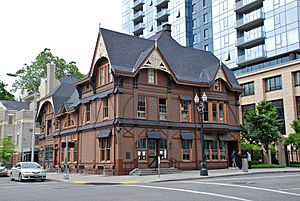

The new South Portland section was approved in 2018. It includes areas like Lair Hill and Johns Landing. This change helps make addresses clearer.
The Pearl District in Northwest Portland used to have warehouses. Now it has fancy art galleries, restaurants, and shops. It is one of the richest neighborhoods. Areas west of the Pearl District include Uptown and Nob Hill. NW 23rd Ave. is a popular shopping street.
Northeast Portland has the Lloyd District, Alberta Arts District, and Hollywood District. North Portland is mostly homes and factories. It has Kelley Point Park, the city's northernmost point. The St. Johns neighborhood is historically very diverse.
Old Town Chinatown is next to the Pearl District. In 1890, it was the second largest Chinese community in the U.S. Southwest Portland is mostly residential. Downtown Portland has businesses, museums, and tall buildings. Portland's South Waterfront area is growing with shops and apartments.
Southeast Portland is mostly residential. It includes neighborhoods like Hawthorne District and Mount Tabor. Reed College, a private college, is also in Southeast Portland.
People and Culture
Population and Diversity
| Historical population | |||
|---|---|---|---|
| Census | Pop. | %± | |
| 1860 | 2,874 | — | |
| 1870 | 8,293 | 188.6% | |
| 1880 | 17,577 | 111.9% | |
| 1890 | 46,385 | 163.9% | |
| 1900 | 90,426 | 94.9% | |
| 1910 | 207,214 | 129.2% | |
| 1920 | 258,288 | 24.6% | |
| 1930 | 301,815 | 16.9% | |
| 1940 | 305,394 | 1.2% | |
| 1950 | 373,628 | 22.3% | |
| 1960 | 372,676 | −0.3% | |
| 1970 | 382,619 | 2.7% | |
| 1980 | 366,383 | −4.2% | |
| 1990 | 437,319 | 19.4% | |
| 2000 | 529,121 | 21.0% | |
| 2010 | 583,776 | 10.3% | |
| 2020 | 652,503 | 11.8% | |
| 2023 (est.) | 630,498 | 8.0% | |
In 2020, Portland's population was 73.8% White, 8.2% Asian, and 5.8% Black or African American. About 10.3% of the population was Hispanic or Latino.
During World War II, many Black people moved to Portland for jobs. They settled in areas like the Albina district. After a big flood in 1948, many Black families had to move. They faced challenges in finding new homes.
Over two-thirds of Oregon's African-American residents live in Portland. Portland also has a large Vietnamese American population, making up 2.2% of the city. There are also many Chinese, Filipino, Japanese, and Korean residents.
Portland has historically been a mostly White city. However, it is becoming more diverse.
Households and Lifestyle
In 2010, there were 583,776 people living in Portland. The city had 235,508 households. The population grew by 10.3% between 2000 and 2010. Portland is expected to continue growing.
The average household size was 2.3 people. The median age in the city was 35 years. In 2010, most residents (80.9%) spoke English at home. About 8.1% spoke Spanish.
Portland has a large LGBT community. In 2015, it had the second highest percentage of LGBT residents in the U.S. The city held its first pride festival in 1975.
Religion in Portland

Portland is known as one of the least religious cities in the United States. Over 42% of residents say they are not connected to a religion.
| Religious affiliation (2020) | ||||
|---|---|---|---|---|
| Unaffiliated | 64% | |||
| Catholic | 15.3% | |||
| Protestant | 14.8% | |||
| Latter-day Saint (Mormon) | 2.3% | |||
| Orthodox | 0.5% | |||
| Buddhist | 1.2% | |||
| Jewish | 0.9% | |||
| Muslim | 0.3% | |||
| Hindu | 0.3% | |||
| Other faiths | 0.4% | |||
Community Challenges
A 2019 survey showed that homelessness is a big challenge for Portland. The city is working to address this issue. The proposed budget for 2022–23 includes money for affordable housing and "safe rest villages." In 2022, the city council approved a plan to help people experiencing homelessness move into shelters.
Economy and Jobs
Portland's location helps its economy. It has low energy costs, good resources, and easy access to highways, airports, and shipping ports. The Port of Portland handles over 13 million tons of cargo each year. It is the third-largest export port on the U.S. West Coast.
The scrap steel industry has been important in Portland for a long time. Companies like Schnitzer Steel Industries ship a lot of scrap metal. Other heavy industry companies include ESCO Corporation.
Technology is a big part of Portland's economy. There are over 1,200 technology companies in the area. This has led to the nickname Silicon Forest. Intel is the largest employer in the Portland area, with over 15,000 jobs.
Many sports and outdoor gear companies have their headquarters in Portland. These include Nike, Adidas, Columbia Sportswear, and Keen.
Other well-known Portland companies include Precision Castparts Corp., Laika (an animation studio), and Daimler Trucks North America. Famous retailers like Fred Meyer and Powell's Books are also based here.
Portland is also known for its breweries. It has 139 breweries and microbreweries, one of the most in the nation. The city also has a strong coffee culture with over 20 coffee roasters.
Top Employers in Portland
Here are some of the biggest employers in Portland:
| # | Employer | Number of employees |
|---|---|---|
| 1 | Providence Health & Services | 23,100 |
| 2 | Intel Corporation | 22,328 |
| 3 | Oregon Health & Science University | 19,603 |
| 4 | Nike, Inc. | 15,522 |
| 5 | Legacy Health | 13,087 |
| 6 | Kaiser Foundation Health Plan | 12,514 |
| 7 | Fred Meyer | 9,000 |
| 8 | Portland Public Schools | 7,111 |
| 9 | City of Portland | 6,753 |
| 10 | Multnomah County | 6,317 |
Housing in Portland
In 2016, home prices in Portland grew faster than in any other U.S. city. Apartment rental costs in November 2019 were about $1,337 for a two-bedroom and $1,133 for a one-bedroom.
Developers planned to build 6,500 more apartments in the Portland area. However, the number of homes available for rent or purchase is still low. Housing prices continue to rise. Many people from other states are moving to Portland. This affects how many homes are available.
Arts and Culture in Portland
Music, Film, and Performing Arts
Portland has many classical performing arts groups. These include the Portland Opera, Portland Baroque Orchestra, and Oregon Symphony. The Portland Youth Philharmonic, started in 1924, was the first youth orchestra in the United States. The city also has theaters like the Oregon Ballet Theatre and Portland Center Stage.
In 2013, The Guardian newspaper called Portland's music scene one of the "most vibrant" in the U.S. Famous bands like Kingsmen and Paul Revere & the Raiders are from Portland. Other well-known groups include Dandy Warhols, Pink Martini, and Decemberists. More recently, Portugal. The Man and the Shins have made Portland their home.
Many films have been shot in Portland. Director Gus Van Sant has filmed many of his movies here. The city has also been featured in TV shows. The IFC show Portlandia was filmed in Portland. It made fun of the city's liberal ideas and unique lifestyles. MTV's The Real World: Portland was also filmed here in 2013.
Portland has many movie theaters that serve beer. These "brew and view" theaters are popular. Examples include the Bagdad Theater and Laurelhurst Theater. Portland also hosts the world's longest-running H. P. Lovecraft Film Festival.
Museums and Fun Places
Portland has many museums and educational places. These include art museums and science centers. The Oregon Museum of Science and Industry (OMSI) has five main halls and a submarine. The World Forestry Center Discovery Museum teaches about forests.
In Washington Park, you can find the Hoyt Arboretum, International Rose Test Garden, Japanese Garden, and Oregon Zoo. The Portland Art Museum has the city's largest art collection. The Oregon Historical Society Museum shares Oregon's history.
Oaks Amusement Park is Portland's only amusement park. It has been open since 1905. It was once called the "Coney Island of the Northwest."
Food and Drink Scene
Food carts are very popular in Portland. There are over 600 licensed carts. The city is home to Stumptown Coffee Roasters and many other coffee roasters.
Portland has 58 active breweries. This makes it one of the top cities for breweries in the U.S. Portland hosts many beer festivals throughout the year. The Oregon Brewers Festival is the largest outdoor craft beer festival in North America.
Public Art in Portland
Portland has over 400 pieces of public art. One of the oldest is Skidmore Fountain, finished in 1888. Most art is cared for by the Regional Arts & Culture Council. In 1980, the city decided to use some money from big city projects to fund public art.
Sports in Portland
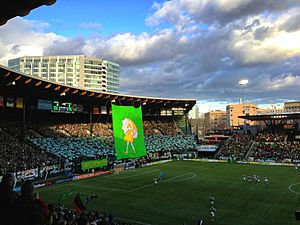
Portland has three major league sports teams. These are the Portland Trail Blazers (basketball), the Portland Timbers (men's soccer), and the Portland Thorns FC (women's soccer). In 2015, the Timbers won the MLS Cup. This was the first men's professional sports championship for Portland since the Trail Blazers won in 1977.
Portland sports fans are very passionate. The Trail Blazers sold out every home game for 814 games in a row. The Timbers have also sold out every home match since joining their league. In 2024, it was announced that Portland would get a WNBA team starting in 2026.
The annual Cambia Portland Classic women's golf tournament is held nearby. It is the longest-running non-major tournament on the LPGA Tour.
Portland has two universities with sports teams: the University of Portland Pilots and the Portland State University Vikings. Many Portland residents also support the University of Oregon Ducks and Oregon State University Beavers.
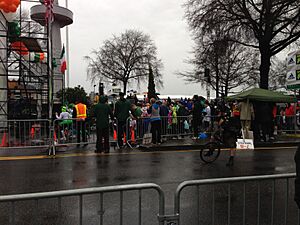
Running is popular in Portland. The city hosts the Portland Marathon and parts of the Hood to Coast Relay. Cycling is also a big activity. Portland is known as one of the most bicycle-friendly cities in the world. It has many bike lanes and services. A new bicycle-sharing system, Biketown, started in 2016.
Here are some of Portland's sports teams:
| Club | Sport | Current League | Championships | Venue | Founded |
|---|---|---|---|---|---|
| Hillsboro Hops | Baseball | Northwest League | 3 (2014, 2015, 2019) | Hillsboro Ballpark | 2013 |
| PDX FC | Soccer | USL 2 | 0 | La Salle Catholic High School Stadium | 2017 |
| Portland Pickles | Baseball | WCL | 1 (2024) | Walker Stadium (baseball) | 2018 |
| Portland Thorns FC | Soccer | NWSL | 4 (2013, 2017, 2021 NWSL Challenge Cup, 2022) | Providence Park | 2012 |
| Portland Timbers | Soccer | MLS | 1 (2015) | Providence Park | 2009 |
| Portland Timbers 2 | Soccer | MLS Next Pro | 0 | Providence Park | 2014 |
| Portland Trail Blazers | Basketball | NBA | 1 (1977) | Moda Center | 1970 |
| Portland Winterhawks | Hockey | WHL | 5 (1981–82, 1983 Memorial Cup, 1997–98, 1998 Memorial Cup, 2012–13) | Veterans Memorial Coliseum | 1976 |
| Rip City Remix | Basketball | NBA G League | 0 | Chiles Center | 2023 |
| Portland WNBA team | Basketball | WNBA | 0 | Moda Center | 2024 |
| Oregon Soar | Ultimate (sport) | WUL | 0 | TBA | 2024 |
| Oregon Steel | Ultimate (sport) | UFA | 0 | Providence Park | 2022 |
| Rose City Rollers | Roller derby | WFTDA | 3 (2015, 2016, 2018) | The Hangar at Oaks Amusement Park | 2004 |
Parks and Recreation
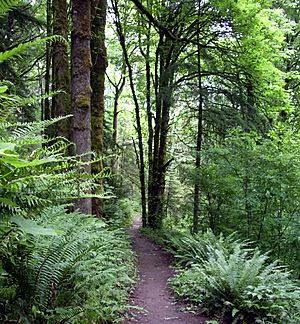
Portland has many parks and green spaces. In 1995, people voted to buy natural areas to protect fish, wildlife, and nature. Over 8,100 acres (3,278 ha) of natural areas have been protected.
Portland is one of only four U.S. cities with extinct volcanoes inside its borders. Mount Tabor Park is known for its views and historic reservoirs.
Forest Park is the largest wilderness park within city limits in the United States. It covers over 5,000 acres (2,023 ha). Portland is also home to Mill Ends Park, the world's smallest park. It is only about 0.3 square meters. Washington Park is west of downtown. It has the Oregon Zoo, Hoyt Arboretum, Japanese Garden, and International Rose Test Garden. Portland also has the Lan Su Chinese Garden, a beautiful Chinese-style garden.
Downtown Portland has the North and South Park Blocks. The Tom McCall Waterfront Park was built in 1974. It hosts many events. The Burnside Skatepark and five indoor skateparks make Portland a very "skateboard-friendly town."
Tryon Creek State Natural Area is one of three Oregon State Parks in Portland. It is very popular. In February 2015, the city banned smoking in all city parks.
Education in Portland
Schools for Kids and Teens

Nine public school districts serve parts of Portland. There are also many private schools. Portland Public Schools is the largest district, with 86 public schools. Other districts include Beaverton School District and David Douglas School District.
David Douglas High School has the most students of any public high school in the city. Other high schools include Benson, Cleveland, and Grant. Lincoln High School, founded in 1869, is the city's oldest public school.
Colleges and Universities
Portland State University has almost 30,000 students. It is the second-largest university in Oregon. It is known for its business and urban planning programs. The city also has the Oregon Health & Science University and Portland Community College.
Private universities include the University of Portland, Reed College, and Lewis & Clark College.
Media in Portland

The Oregonian is the main daily newspaper in Portland. It is also read throughout Oregon.
Smaller local newspapers are free. These include the Portland Tribune and Willamette Week. The Portland Mercury is for younger readers. There are also newspapers for specific communities, like The Asian Reporter and The Skanner (an African-American newspaper). Portland Monthly is a monthly magazine about news and culture.
City Services and Transportation
Healthcare Services
Legacy Health is a non-profit healthcare system in Portland. It runs several hospitals, including Legacy Emanuel and Legacy Good Samaritan. Randall's Children's Hospital is on the Legacy Emanuel Campus.
Providence Health & Services operates Providence Portland Medical Center. Oregon Health & Science University is a university hospital. The Veterans Affairs Medical Center is next to OHSU.
Getting Around Portland
Portland has many ways to get around. Oregon focuses on good city planning. This means people have many choices for commuting.
TriMet runs most of the city's buses and the MAX system. MAX is a light rail system that connects the city and suburbs. It has five lines. The Portland Streetcar serves downtown and nearby areas.
I-5 connects Portland to California in the south and Washington state in the north. U.S. 26 goes to the Pacific Ocean in the west and Mount Hood in the east.
Portland's main airport is Portland International Airport (PDX). It is about 20 minutes from downtown by car. Amtrak, the national passenger rail system, serves Portland at Union Station.
Portland is the only U.S. city that owns working mainline steam locomotives. These trains are sometimes used for special trips.
Cycling is a popular way to get around. Portland is known as one of the most bicycle-friendly cities in the world. It has many bike lanes and services. A new bicycle-sharing system, Biketown, started in 2016.
Water Supply
Portland's main drinking water comes from reservoirs in the Bull Run Watershed. This area has about 102 square miles (264 km²) of forest. The city also has groundwater wells near the Columbia River. These wells help supply water in the summer.
Notable People
Sister Cities
Portland has "sister city" relationships with other cities around the world. These relationships help promote cultural exchange and understanding.
Portland also has a friendship city agreement with:
 Utrecht, Netherlands (2012)
Utrecht, Netherlands (2012)
See also
 In Spanish: Portland para niños
In Spanish: Portland para niños
Images for kids
-
Pioneer Courthouse, 1886
-
Protests at the Mark O. Hatfield Courthouse, July 2020


